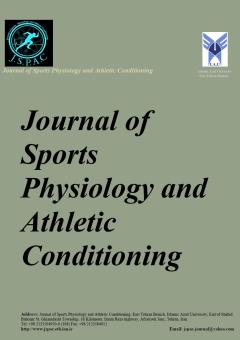The Role of Conscious Control Propensity in Determining the Effects of Attentional Foci instructions
الموضوعات : Physical Fitness
Mohammad Tollabi
1
,
Elaheh Arab Ameri
2
,
Mehdi Shahbazi
3
,
Alireza Babaei Mazreno
4
![]() ,
Fatemeh Sadat Tabatabaei
5
,
Fatemeh Sadat Tabatabaei
5
1 - Ph.D. Student of Motor Behavior. Faculty of Sport Sciences and Health, Tehran University, Tehran, Iran.
2 - Associate Professor of Motor Behavior, Faculty of Sport Sciences and Health, Tehran University, Tehran, Iran.
3 - Associate Professor of Motor learning and control, Faculty of Sport Sciences and Health, Tehran University, Tehran, Iran.
4 - Department of Sport Sciences, Isfahan (Khorasgan) Branch, Islamic Azad University, Isfahan, Iran.
5 - Ph.D. in TEFL, Farhangian University, Yazd, Iran.
الکلمات المفتاحية: Conscious control propensity, attentional foci, performance, motor learning, basketball accuracy pass,
ملخص المقالة :
Background: In this research, we investigated the role of conscious control propensity in determining the effects of attentional foci on performance and learning of basketball accuracy pass in children (10-12 years old). Materials and Methods: To determine the children’s conscious control propensity, the Movement Specific Reinvestment Scale was used. Seventy-two children in two high and low conscious control groups that each group divided to three sub-groups (internal, external, and control) entered the acquisition and transfer and retention tests in the basketball accuracy pass task. Results: The results showed that during the acquisition period, low and high conscious control propensity did not have any effect. Though there was a significant interaction between conscious control propensity and attentional foci in transfer and retention tests, but the main effects were not significant. Conclusion: Based on these results, children's motor learning is more effective when the instructions for attentional foci suited their natural tendencies.
1. Wulf G, Höß M, Prinz W. Instructions for motor learning: differential effects of internal versus external focus of attention. J Mot Behav. 1998 Jun;30(2):169-79. doi: 10.1080/00222899809601334. PMID: 20037032.
2. Shear, J. and R. Jevning, Pure consciousness: Scientific exploration of meditation techniques. 1999, Thorverton, UK: Imprint Academic.
3. van Ginneken, W.F., et al., Comparing the effects of conscious monitoring and conscious control on motor performance. Psychology of Sport and Exercise, 2017. 30: p. 145-152
4. Wulf, G., Attentional focus and motor learning: a review of 15 years. International Review of Sport and Exercise Psychology, 2013. 6(1): p. 77-104.
5. Wulf G, Shea C, Park JH. Attention and motor performance: preferences for and advantages of an external focus. Res Q Exerc Sport. 2001 Dec;72(4):335-44. doi: 10.1080/02701367.2001.10608970. PMID: 11770783.
6. Naderi Rad, N., A.A. Jaberi Moghadam, and S. Tahmasebi Boroujeni, The Effect of Attentional Focus of Supra-Postural Task on Performance and Learning of Postural Control in Girls Aged Between 9 and 12. Development & Motor Learning, 2017. 9(3): p. 267-283 .
7. Rhea CK, Diekfuss JA, Fairbrother JT, Raisbeck LD. Postural Control Entropy Is Increased When Adopting an External Focus of Attention. Motor Control. 2019 Apr 1;23(2):230-242. doi: 10.1123/mc.2017-0089. Epub 2018 Dec 5. PMID: 30518283.
8. Abdolmaleki, H., Ghafari, B. The Effect of Attention Focus ofInstruction on Novices' Skill LearningBased on Newell’s Learning StagesModel. Journal of Sports and Motor Development and Learning, 2016; 8(3): 485-494. doi: 10.22059/jmlm.2016.59383
9. Thorn, J.E., Using attentional strategies for balance performance and learning in nine through 12 year olds. 2006.
10. Pollock BJ, Lee TD. Dissociated contextual interference effects in children and adults. Percept Mot Skills. 1997 Jun;84(3 Pt 1):851-8. doi: 10.2466/pms.1997.84.3.851. PMID: 9172193.
11. Ruitenberg MF, Abrahamse EL, Verwey WB. Sequential motor skill in preadolescent children: the development of automaticity. J Exp Child Psychol. 2013 Aug;115(4):607-23. doi: 10.1016/j.jecp.2013.04.005. Epub 2013 May 22. PMID: 23708125.
12 Mehrabeyan, G., Heirani, A., Gholipoor, M. The Effect of Different Focus of Attention Instructions and Cognitive Styles on the Learning of Dart Throwing Skill. Journal of Sports and Motor Development and Learning, 2016; 8(1): 159-174. doi: 10.22059/jmlm.2016.59266.
13. Masters, R., F.F. Eves, and J.P. Maxwell. Development of a movement specific reinvestment scale. in International Society of Sport Psychology (ISSP) World Congress. 2005. International Society of Sport Psychology(ISSP).
14. Emanuel M, Jarus T, Bart O. Effect of focus of attention and age on motor acquisition, retention, and transfer: a randomized trial. Phys Ther. 2008 Feb;88(2):251-60. doi: 10.2522/ptj.20060174. Epub 2007 Nov 27. PMID: 18042657.
15. Soleimani Rad, M., Tahmasebi Broojeni, S., Mehrsafar, A. H. Psychometric Properties of Persian Version of Movement- and Decision -Specific Reinvestment Scales. Sport Psychology Studies, 2017; 6(20): 97-118. doi: 10.22089/spsyj.2017.3281.1338
16. Johnson, B.L. and J.K. Nelson, Practical measurements for evaluation in physical education. Third edition ed. 1988 .
17. Tse, A.C. and W.F. van Ginneken, Children's conscious control propensity moderates the role of attentional focus in motor skill acquisition. Psychology of Sport and Exercise, 2017. 31: p. 35-39 .
18. Hawk, T.F. and A.J. Shah, Using learning style instruments to enhance student learning. Decision Sciences Journal of Innovative Education, 2007. 5(1): p. 1-19.
19. Riyahi Malayeri, S., Nikbakht, H, Gaeini (2014). Serum Chemerin Levels and Insulin Resistance Response to High- Intensity Interval Training in Overweight Men. Bulletin of Environment, Pharmacology and Life Sciences, 3(2), pp. 385-389.


